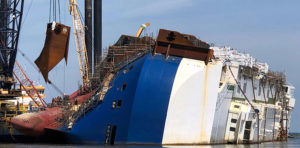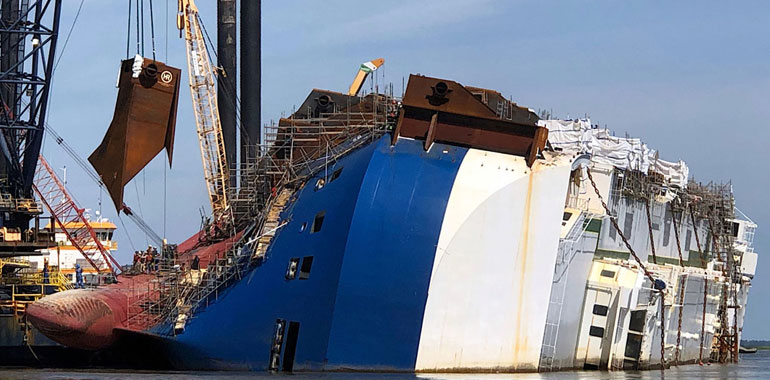
While the salvage of the sunken vehicle carrier Golden Ray was delayed for months due to COVID-19 and the hurricane season, analysis by the U.S. Coast Guard has determined a possible cause for the rollover: a combination of vehicles placed too high on the ship’s decks, and not enough ballast water given the placement of the cargo.
On Sept. 8, 2019, the Marshall Islands-flagged Golden Ray, loaded with 4,200 vehicles, was exiting Brunswick Harbor in Georgia bound for the Port of Baltimore. With 23 Korean crew and a Brunswick pilot on board, the vessel began to list severely while making a starboard turn. The 656-foot ship capsized and came to rest half-submerged in St. Simons Sound.
During a four-day virtual public hearing in Brunswick, Ga., in September, Coast Guard investigators cited the placement of the vehicles and inadequate ballast for the incident. The service and the National Transportation Safety Board (NTSB) continue to investigate and will release final reports and any safety recommendations in about a year.
Hyunjin Park, a South Korean citizen who was first officer on the ship, did not appear at the hearing but did provide statements immediately after the incident. In an interview with the Korean Maritime Safety Tribunal, Park said he did not receive the final stowage plan before leaving the Port of Brunswick. Instead, he used estimated data values based on the pre-stowage plan.
Lt. Ian Oviatt, a staff engineer at the Coast Guard Marine Safety Center, analyzed Golden Ray’s ballast tank loading data and cargo stowage plan and concluded the ship did not comply with the requirements of the International Code on Intact Stability. Due to low ballast levels, the vessel did not have sufficient capacity to right itself after the starboard turn.
Golden Ray, owned by Hyundai Glovis of South Korea, discharged 1,500 metric tons of ballast from two tanks during a previous leg of the voyage from Freeport, Bahamas to Jacksonville, Fla. Had the ship not released this ballast and kept its tanks filled, it’s likely it would not have capsized, Oviatt said.
When the Coast Guard arrived at the scene, Golden Ray was listing at 70 degrees to port. Capt. Jonathan Tennant, the Brunswick pilot who was at the helm, lowered a fire hose through the port bridge wing to reach the Coast Guard rescue boat.
The service and local responders rescued all 24 people on board without injury. Helicopters lifted crewmembers from the starboard bridge wing and aft area of the vessel. Four mariners trapped in the engine room were freed after local salvage operators cut through the hull.
The ship remains on its port side in St. Simons Sound. Salvage operations resumed in early October.
The salvage plan calls for cutting the wreck into eight sections and lifting them onto barges for disposal. Texas-based T&T Salvage welded on 16 lugs, two for each section, to connect rigging to VB 10,000, a U.S.-flagged twin-gantry catamaran. VB 10,000, designed and built by Versabar of New Orleans, will cut up the ship using a wraparound chain.
The vehicles on Golden Ray, which will be scrapped, will be left where they are on the ship and may fall out during the salvage. The wreck is stable and removing it is not expected to impact the deepwater channel or commercial ship traffic.
Extensive environmental precautions were taken to protect sensitive areas in St. Simons Sound. Salvors have removed more than 320,000 gallons of oil and water mixture from the ship.
Gary Wollenhaupt

